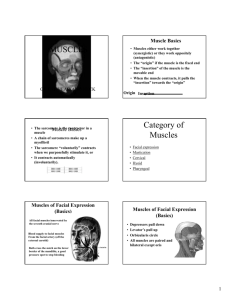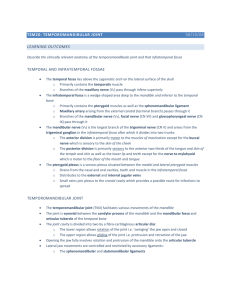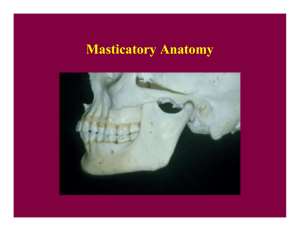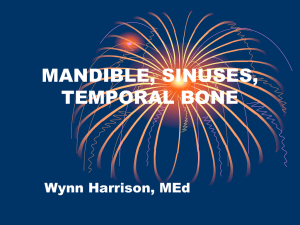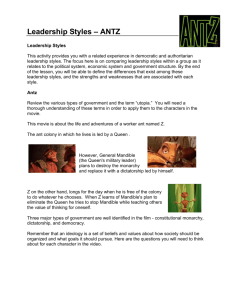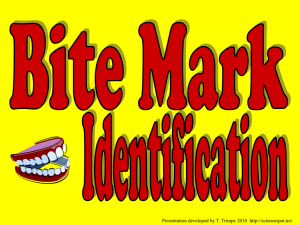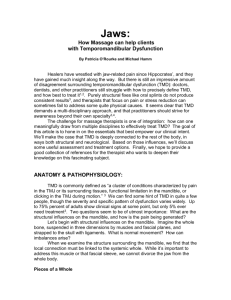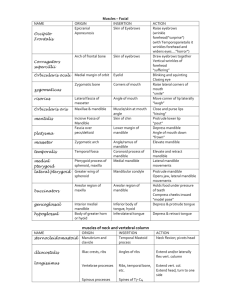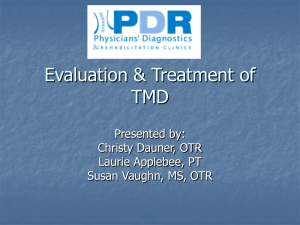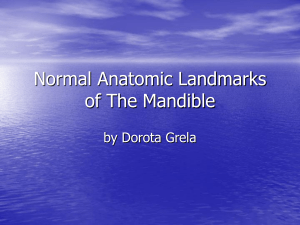Occlusion lec4
advertisement
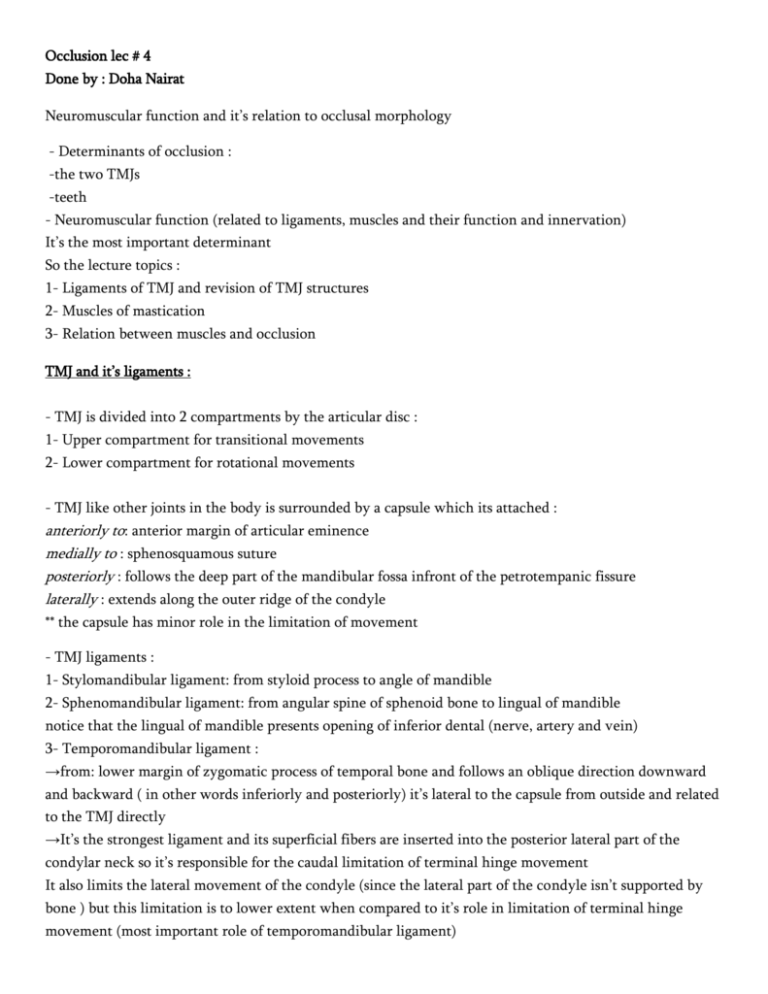
Occlusion lec # 4 Done by : Doha Nairat Neuromuscular function and it’s relation to occlusal morphology - Determinants of occlusion : -the two TMJs -teeth - Neuromuscular function (related to ligaments, muscles and their function and innervation) It’s the most important determinant So the lecture topics : 1- Ligaments of TMJ and revision of TMJ structures 2- Muscles of mastication 3- Relation between muscles and occlusion TMJ and it’s ligaments : - TMJ is divided into 2 compartments by the articular disc : 1- Upper compartment for transitional movements 2- Lower compartment for rotational movements - TMJ like other joints in the body is surrounded by a capsule which its attached : anteriorly to: anterior margin of articular eminence medially to : sphenosquamous suture posteriorly : follows the deep part of the mandibular fossa infront of the petrotempanic fissure laterally : extends along the outer ridge of the condyle ** the capsule has minor role in the limitation of movement - TMJ ligaments : 1- Stylomandibular ligament: from styloid process to angle of mandible 2- Sphenomandibular ligament: from angular spine of sphenoid bone to lingual of mandible notice that the lingual of mandible presents opening of inferior dental (nerve, artery and vein) 3- Temporomandibular ligament : →from: lower margin of zygomatic process of temporal bone and follows an oblique direction downward and backward ( in other words inferiorly and posteriorly) it’s lateral to the capsule from outside and related to the TMJ directly →It’s the strongest ligament and its superficial fibers are inserted into the posterior lateral part of the condylar neck so it’s responsible for the caudal limitation of terminal hinge movement It also limits the lateral movement of the condyle (since the lateral part of the condyle isn’t supported by bone ) but this limitation is to lower extent when compared to it’s role in limitation of terminal hinge movement (most important role of temporomandibular ligament) ** these suspensory ligaments fix and influence the parameters of envelop of motion of mandible ** remember that the envelop of motion is result of tracing mandibular movements in sagittal plan and affected by the muscles, ligaments and bone . ** the main function of the ligaments is limitation of the movements ------------------------------------------------------------------------------------------------------------------Muscles of mastication : definition: muscles directly responsible for the movement and positioning of the mandible and their activity is initiated voluntary . the muscles of mastication have other functions rather than mastication which are : - speaking - swallowing - yawning **Muscles of mastication can be subdivided to : - muscles for propulsion - muscles for retrusion - muscles for lateral movements - muscles for closing and opening Temporalis : fan shaped muscle and largest muscle of mastication origin: temporal fascia, temporal fossa insertion: coronoid process, anterior border of ramus and articular disc and may be inserted to distal surface of last molar function: • retraction : by the posterior fibers • elevation: by the ant. And middle fibers • during closing the contraction of temporalis muscle holds the articular disc in its place to allow the condyle to return to the disc so elevates the jaw and clenches the teeth so Temporalis is the principle positioned of mandible Masseter : origin : zygomatic arch ¤the superficial portion from anterior 2/3s of lower border of zygomatic arch ¤the deep portion from the medial surface of zygomatic arch insertion : lateral surface of ramus, angle of mandible and coronoid process function : • mandibular elevation especially at forcefull closure (clenching) • may assist in protrusion and lateral movements of mandible Lateral pterygoid : origin : ¤superior head from infratemporal surface of sphenoid greater wing active during various jaw closing movements only, to stabilize the condylar head against the articular eminence during mandibular closing ¤inferior head from lateral surface of lateral pterygoid plate active during jaw opening movement and protrusion only insertion: anterior portion of condylar neck, TMJ capsule and articular disc function: • protrusion of condyle while pulling the disc downward • assist in rotary movements of mandible by pulling the disc forward ** superior fibers are attached to the disc to pull the disk and the condyle at the same time ** lateral pterygoids in the both sides work together in protrusion which is the main function for them ** contra lateral contraction of lateral pterygoid and unicontraction of lateral pterygoid with the middle pterygoid gives 2 different movements Medial pterygoid origin: medial surface of lateral pterygoid plate, pyramidal process of palatine bone and maxillary tuberosity insertion: posterior and lower part of the medial surface of ramus and angle of mandible function: • mainly protraction and elevation of the mandible • may assist in rotary movements and lateral movements of the mandible →Innervation of muscles of mastication: - mandibular nerve of trigeminal nerve →Vascularization : - Maxillary artery and facial artery which are branches from external carotid These are the main 4 muscles of mastication but we can’t say that they are the only muscles that affect the mandible movement .. other muscles affect mandible movement : Suprahyoid muscles which help in opening when the hyoid bone is stabilized hyoid bone is stabilized when the infrahyoids contract →Infrahyoid muscles : 1- thyrohyoid 2- sternohyoid 3- sternothyroid 4- omohyoid Genihyoid Origin: inferior genial tubercle at the inner surface of the mandibular symphysis insertion: anterior surface of the hyoid bone Mylohyoid origin : from the whole length of the mylohyoid line of the mandible, extending from the symphysis in front to the last molar tooth behind insertion : hyoid bone and median raphe Stylohyoid Origin: styloid process Insertion : hyoid bone and it’s junction with greater cornu Digastric : Origin : ¤Anterior belly from digastric fossa of mandible ¤Posterior belly from mastoid notch of temporal bone Insertion : intermediate tendon attached to hyoid bone All the suprahyoids have the same function which is: • elevation of hyoid bone and base of tongue so raise the floor of the mouth • OR depressing the mandible when the hyoid is stabilized Other muscles affect the mandibular movements : 1- Platysma :superficial muscle function: depression of the mandible and lip and tenses the skin 2- Buccinator : function: compresses the cheek and moves bolus of food in mouth for chewing 3- Sternocleidomastoid muscle and trpezius muscle muscles of posterior neck and they are important in stabilizing the skull and head Relationship between muscles and occlusion : - in most people the centric relation is different from the centric occlusion and that causes the interferences due to premature contact between teeth in certain areas so that there will be shift but these interferences are minimal in the normal condition and our system is adapted to them so there’s no muscle pain and no TMJ pain . - In extreme cases great shift happens when the person switches or moves from centric relation to centric occlusion and that causes muscle and TMJ pain. - In normal condition we don’t have to close in centric relation then move to centric occlusion because our system is adapted to close in the right position and that is called (habitual closure position) - In normal closure: • Temporalis ant. Fibers, medial pterygoid and masseter→ elevation of mandible from opening position • Temporalis post. And medial fibers → retraction of mandible backward • Lateral pterygoid relaxes to allow the articular disc to glide back to fossa - Closure interferences (centric interferences) : because of these interferences (premature contact mainly between posterior teeth) there will be shift in order to close in maximum intercuspation which is more comfortable and stable state than centric relation the shift may be : -forward displacement -lateral displacement on the same side of contact or at the opposite side -backward displacement (rare case happens when there’s premature contact between distal slopes of upper teeth and mesial slopes of lower ) ** the magnitude and direction of displacement is dependent on the location of the premature contact 1- Forward displacement of mandible due to the premature contact between the Mesial and distal slopes of cusps when closing the mandible in centric relation causing the mandible to shift to centric occlusion • Premature contact between : Mesial slopes of upper teeth and distal slopes of lower teeth • Muscles affected : - lateral pterygoid: protrude the mandible - Temporalis posterior and medial fibers: can’t complete the retraction of the mandible resulting in hyperactivity of these fibers -----------------------------------------------2- Lateral displacement of mandible: due to the premature contact between the buccal and lingual slopes of cusps when closing the mandible in centric relation causing the mandible to shift to centric ooclusion ** Deviation of the condyle in this case is different from that in lateral movement because the condyle that moves anteriorly doesn’t move downward Examination of TMJ: By PALPATION • Palpation of muscles can be helpful in examination Palpation is done bilateral and at rest .. If the patient feels pain during palpation then there’s problem In palpation to TMJ or the muscles we have to palpate on both sides (bilaterally) with our fingers to make comparison between the 2 sides
